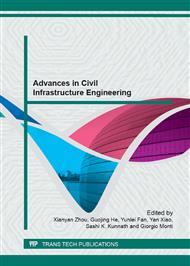p.160
p.164
p.171
p.177
p.183
p.191
p.198
p.206
p.211
Thermal Experiment of a Reinforced Approach Pavement for Semi-Integral Abutment Jointless Bridge
Abstract:
Semi-integral abutment fully jointless bridges, which connecting the main girder, the approach slab and the reinforced approach pavement all together and eliminating all the deck expansion joints and also the approach reinforced pavement joint is studied. As we know, the temperature variation is the key influence factor of the basic performance of the fully jointless bridges. When the temperature drops, the cracks appeared along the reinforced approach pavement. In the paper, emphasisis primarily made on simulating the temperature drops. A 28m full scale model stretching experiment simulating the temperature drops has been carried out in laboratory. After the experiment simulation we found that:(1)The crack width of approach pavement distribute uniformly at the pre-cut joints and their crack widths ranged mainly between 0.2mm and 0.8mm and the mean crack width was 0.37mm when the maximum stretch length at the end of the approach slab reached 9.87mm, which was within AASHTO and the Chinese highway pavement specification allowable value; (2)the load transfer capability coefficient at the third pre-cut joint with the maximum crack width (0.97mm) was 84%,which also satisfied the allowance of Chinese highway pavement specification. So this reinforced approach pavement is safe to connect semi-integral abutment bridge for the temperature length of 45m with the maximum temperature decrement of =20 ºС from the average reference construction temperature.
Info:
Periodical:
Pages:
183-190
Citation:
Online since:
January 2013
Authors:
Price:
Сopyright:
© 2013 Trans Tech Publications Ltd. All Rights Reserved
Share:
Citation:


